Do you have a question about the MOTO GUZZI CALIFORNIA STONE and is the answer not in the manual?
Illustrations and descriptions are indicative; manufacturer reserves right to modify.
Explains special remarks like accident prevention, damage possibility, and additional info.
Details on engine specs, distribution, ignition, fuel, exhaust, lubrication, and starter systems.
Information on clutch, gearbox, drives, frame, suspension, wheels, tyres, and brakes.
Vehicle dimensions, weight, performance data, and refueling information.
English section covering engine, transmission, frame, suspension, wheels, tyres, and brakes.
French overview of engine, lubrication, alternator, ignition, and starter systems.
German overview of engine, lubrication, alternator, ignition, fuel supply, and exhaust systems.
Location and importance of frame and engine identification numbers for legal purposes.
Emphasizes using approved original spares to avoid invalidating warranty rights.
Explains the key switch positions (OFF, ON, LOCK, P) and their functions.
Instructions on how to operate the steering lock mechanism and warnings.
Operation of handlebar switches for headlights, parking lights, and flashers.
Explains the function of push-buttons for horn and turn signal switches.
Operation of the starter button and engine stop switch located on the right handlebar.
How to operate the throttle twist grip and clutch lever for starting and gear changes.
Operation of front and rear brake levers and pedals.
Operation of the choke lever for cold starts.
Operation of the rear brake pedal.
Details on the gear change pedal operation and sequence for shifting gears.
Instructions for opening, closing, and handling fuel spills at the filler cap.
Explains the automatic operation of the electric fuel cock and troubleshooting.
Identifies the location of the fuse box and the function of each fuse.
Explains the function of the steering damper and how to adjust its effect.
Instructions for attaching, releasing, and opening side bags and top-case.
Specifies the maximum allowed load for side bags and top-case.
Explains how to lock and unlock the rider's saddle using the device.
Instructions for using the helmet holder and warnings about leaving helmet attached.
How to access the storage compartment under the rider's seat.
Explains the side stand's function for parking and its safety interlock with the starter.
Essential pre-ride checks including fuel, oil, ignition, warning lights, and controls.
Procedures for cold and warm engine starts, including choke usage and starter operation.
Steps for safely stopping the motorcycle using brakes and clutch.
Instructions for parking, including use of parking lights and key positions.
Rules to follow during the initial period, including engine warm-up and RPM limits.
Maintenance tasks required after the first 500-1500 km, including oil changes and checks.
How to adjust the free play in the clutch lever and cable for proper operation.
Steps to adjust the position of the rear brake pedal for rider comfort and control.
Procedure for checking brake pad thickness and replacement recommendations.
Guidelines for inspecting brake discs for cleanliness, scoring, and tightening torque.
How to check brake fluid levels, top up, and recommendations for fluid replacement.
Warning against using mineral oils/greases and safe handling of brake fluid.
How to adjust the spring pre-load for optimal motorcycle stability and handling.
How to adjust the steering column to ensure free movement without play for safe riding.
Step-by-step guide for removing and refitting the front wheel.
Detailed steps for removing the rear wheel from the fork arm and gearbox.
Recommended tyre pressures for front and rear wheels under different load conditions.
Advice on minimum tread depth and tyre replacement guidelines.
Instructions for fitting tyres, including bead seating and directional arrows.
A comprehensive table outlining maintenance tasks at various mileage intervals.
Preparation, washing, and drying instructions, including product recommendations.
Steps for preparing the motorcycle for extended storage, including cleaning and battery care.
Guidelines for cleaning the windscreen, including recommended products and warnings.
Procedure for checking engine oil level and topping up as needed.
Details on recommended engine oil grades and viscosity based on temperature.
Instructions and intervals for changing engine oil, including hot oil change procedure.
Steps for replacing the oil filter cartridge and cleaning the mesh filter.
Procedure for checking and changing the oil in the gearbox.
Instructions for checking and changing the oil in the rear transmission box.
Procedure and intervals for changing the front fork oil.
Locations requiring greasing, such as steering and swinging arm bearings.
How to check and adjust tappet clearances for proper engine timing and noise reduction.
Explains the "alfa/N" system, air measurement, fuel delivery, and ignition timing control.
Details components of the fuel and air intake systems, including injectors and throttle body.
Explains how the ECU monitors engine conditions and controls fuel delivery and ignition.
Describes how the ECU calculates parameters like injection time and spark advance.
Details the ECU's role during engine starting, including fuel enrichment.
Explains how fuel delivery increases during acceleration for better handling.
Critical warnings regarding battery handling, electrical connections, and spark plug components.
How to adjust the engine’s idle speed to the recommended RPM range.
Details the fuel filter specifications and recommended replacement interval.
Instructions for checking, cleaning, and replacing the air filter.
Specifies the correct spark plug type, gap, and periodic removal for cleaning.
Warnings about spark plug replacement intervals and improper handling of ignition components.
Lists all the components that make up the motorcycle's electrical system.
Steps to remove the saddle and tool box to access the battery.
Guidelines for maintaining lead-acid batteries, including electrolyte levels and charging.
Warnings about handling battery acid, explosive gases, and proper charging environment.
Information specific to the maintenance-free battery used in certain regions.
Specific instructions for recharging this battery type and associated safety warnings.
Steps to replace headlight bulbs, with a warning about touching the glass.
How to replace bulbs in the tail light and direction indicators, with warnings.
Steps to remove the odometer housing and replace the bulb.
Procedure for accessing and replacing bulbs for the dashboard indicators.
How to adjust the headlight beam vertically for safe riding and to avoid dazzling others.
A table listing all bulbs used in the motorcycle and their respective wattages.
A comprehensive legend detailing electrical components and their numbering in the wiring diagram.
Lists all fuses with their corresponding circuits and amperage ratings.
| Engine Type | V-Twin, 4-stroke |
|---|---|
| Displacement | 1064 cc |
| Bore x Stroke | 92 mm x 80 mm |
| Cooling System | Air-cooled |
| Fuel System | Electronic fuel injection |
| Ignition | Electronic |
| Transmission | 5-speed |
| Final Drive | Shaft |
| Front Tire | 110/90-18 |
| Rear Tire | 140/80-17 |
| Seat Height | 780 mm |
| Front Suspension | Telescopic fork |
| Rear Suspension | Dual shocks |
| Front Brakes | Disc |
| Rear Brakes | Disc |
| Fuel Capacity | 19 liters |
| Power | 74 hp |
| Torque | 94 Nm |
| Wheelbase | 1560 mm |


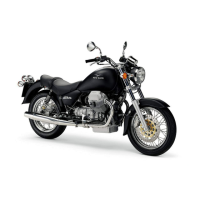

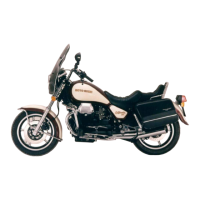
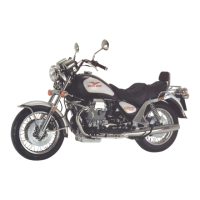
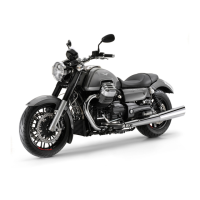
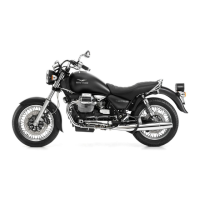
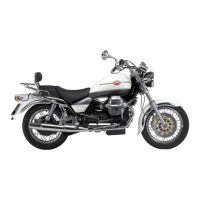
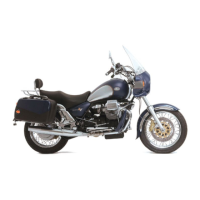
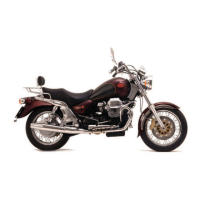
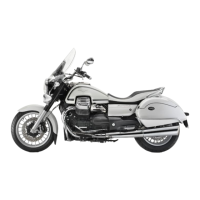
